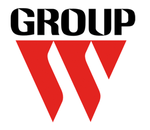 | |
| Group W | |
| Company type | Division |
| Industry | Radio and television broadcasting |
| Founded | November 2, 1920, in East Pittsburgh, Pennsylvania, U.S. (with the establishment of KDKA) |
| Defunct |
|
| Fate | Merged into CBS, remained as a licensee until 1999 |
| Successor | |
| Headquarters | , |
Area served | United States |
| Parent | Westinghouse Electric |
The Westinghouse Broadcasting Company, also known as Group W, was the broadcasting division of Westinghouse Electric Corporation. It owned several radio and television stations across the United States and distributed television shows for syndication.
Westinghouse Broadcasting was formed in the 1920s as Westinghouse Radio Stations, Inc. After expanding into television, it was renamed Westinghouse Broadcasting Company in 1954, and adopted the Group W moniker on May 20, 1963. It was a self-contained entity within the Westinghouse corporate structure; while the parent company was headquartered in Pittsburgh, Pennsylvania, Westinghouse Broadcasting maintained headquarters in New York City. It kept national sales offices in Chicago and Los Angeles.
Group W stations are best known for using a distinctive corporate typeface, introduced in 1963, for their logos and on-air imaging.[1][2] Similarly styled typefaces had been used on some non-Group W stations as well and several former Group W stations still use it today. The Group W corporate typeface has been digitized and released freely by John Sizemore;[2] Ray Larabie's font "Anklepants [3] borrows heavily from the typeface and is occasionally used as a substitute.[4] The font is also used in the video game Damnation.
Westinghouse Broadcasting was also well known for two long-running television programs, the Mike Douglas Show and PM Magazine (called Evening Magazine in Group W's core broadcast markets).
- ^ "John Sizemore".
- ^ a b "Westinghouse Font | John Sizemore". October 22, 2013.
- ^ Larabie, Raymond (April 4, 2024). 729 Typodermic Fonts Released Into the Public Domain. Typodermic Fonts. Retrieved May 29, 2024.
- ^ "Anklepants – Typodermic Fonts".
